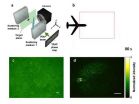(Press-News.org) CINCINNATI—An antibody abundant in mice and previously thought to offer poor assistance in fighting against infection may actually play a key role in keeping immune responses in check and preventing more serious self-inflicted forms of kidney disease, researchers say.
Led by researchers at the University of Cincinnati (UC) and Cincinnati Children's Hospital Medical Center and published online Nov. 2, 2014, in the journal Nature, the study finds that the mouse antibody IgG1, which is made in large quantities and resembles a human antibody known as IgG4, may actually be protective.
"Antibodies protect against pathogens, in large part, by clumping them together and by activating other defenses, including a set of serum proteins, known as complement, and cells that have antibody-binding molecules on their surface called Fc receptors," says Fred Finkelman, MD, Walter A. and George McDonald Foundation Chair of Medicine and professor of medicine and pediatrics at UC.
Finkelman is also an immunobiology researcher at Cincinnati Children's Hospital Medical Center. Richard Strait, MD, an assistant professor of pediatrics at UC and an attending physician at Cincinnati Children's, is the first author of the research published in Nature.
"Surprisingly, most of the antibody made by mice is IgG1, which is relatively defective in its ability to clump pathogens, activate complement, and activate cells by binding to their Fc receptors," says Finkelman, also a physician at the Cincinnati Department of Veterans Affairs (VA) Medical Center. "Humans have a similar type of antibody, called IgG4, which is also relatively defective in these abilities.
"Why should you have such a wimpy antibody? It's the antibody made in the largest amount. Our thought was that in biology, you don't get anything for free," says Finkelman. "If an antibody can kill bacteria and viruses very well, it might also cause inflammation that can harm the animal that makes it. So maybe you need some of these wimpy antibodies to protect against that type of self-inflicted damage."
Researchers tested their hypothesis by studying what happens when genetically bred mice that cannot make IgG1 are injected with a foreign protein that would spur a normal mouse's immune system to produce IgG1. The genetically bred mouse instead produced another antibody known as IgG3, which affected capillaries in the kidneys and ultimately led to renal failure.
"The mouse's kidneys turned yellow because they essentially shut off blood flow and within a few days there was total destruction of the filtering part of the kidney called the glomerulus," explains Finkelman.
However, injecting IgG1 into mice that could not make the antibody prevented them from developing kidney disease, says Finkelman.
"These findings support our hypothesis about the reason for making antibodies such as mouse IgG1 and human IgG4," says Finkelman. "They also demonstrate a new type of kidney disease that can be caused by certain types of antibody, such as mouse IgG3, even without complement or Fc receptors. In addition, our findings suggest that antibodies such as human IgG4 might be useful for treating people who have diseases caused by other types of antibody."
These diseases include myasthenia gravis and blistering skin diseases, says Finkelman.
Myasthenia gravis is a chronic autoimmune neuromuscular disease characterized by varying degrees of weakness of the skeletal (voluntary) muscles of the body. Individuals with the ailment lose the ability to contract their muscles because their body produces an antibody that destroys acetylcholine receptors in muscle.
"The nerves in their muscles continue to fire and they release the chemical acetylcholine, but there is not much for the acetylcholine to bind to," says Finkelman. "These people become very weak and can actually die because they can no longer swallow well or breathe well."
Individuals with blistering skin diseases make antibodies against the molecules that hold skin cells together, says Finkelman. As a result, the skin cells separate from each other, forming blisters.
"People can lose a lot of fluid and can get infected very easily," says Finkelman. "These are very serious diseases and the treatment is not very good."
INFORMATION:
Funding for this study came from a U.S. Department of Veterans Affairs Merit Award, the National Institutes of Health (R01 A1072040), the University of Cincinnati and Cincinnati Children's Hospital Medical Center.
Co-authors include; Ashley Mahler, Nathaniel Barasa, Jörg Köhl, MD; Keith Stringer, MD; Shiva Kumar Shanmukhappa, DVM, PhD; David Witte, MD; Md Monir Hossain, PhD; Marat Khoudou; PhD; and Andrew Herr, PhD; all affiliated with the University of Cincinnati and/or Cincinnati Children's; Chaim Jacob, MD, PhD, University of Southern California School of Medicine; and Marc Ehlers, University of Lübeck, Germany. Köhl is also affiliated with the University of Lübeck, Germany. Monica Posgai, PhD, is a recent postdoctoral fellow at the University of Cincinnati.
Two photons in free space do not interact. Light waves can pass through each other without having any influence on each other at all. For many applications in quantum technology, however, interaction between photons is crucial. It is an indispensable prerequisite for transmitting information through tap-proof quantum channels or for building optical logic gates. At the Vienna University of Technology (TU Wien), scientists have now succeeded in establishing a strong interaction between two single photons. This opens up completely new possibilities for quantum optics. The ...
As a child, it was fascinating to put a flashlight up to our palms to see the light shine through the hand. Washington University in St. Louis engineers are using a similar idea to track movement inside the body's tissues to improve imaging of cancerous tissues and to develop potential treatments.
Lihong Wang, PhD, the Gene K. Beare Distinguished Professor of Biomedical Engineering at the School of Engineering & Applied Science is applying a novel time-reversal technology that allows researchers to better focus light in tissue, such as muscles and organs.
Current ...
Nate Silver and Richard Feynman walk into a bar and bump into a biologist . . .
While this may sound like the setup to some late-night nerd sketch, researchers have taken this premise and applied it to an increasingly cumbersome problem in modern biology, namely, finding meaning in the rising oceans of genomic data.
In this specific instance, the data comprisesreams of cancer mutations that genome-wide studies are publishing at a dizzying rate. The challenge is finding new and efficient ways to parse the signal from the noise (and there is no shortage of noise).
As ...
A disappearing act was the last thing Rice University physicist Randy Hulet expected to see in his ultracold atomic experiments, but that is what he and his students produced by colliding pairs of Bose Einstein condensates (BECs) that were prepared in special states called solitons.
Hulet's team documented the strange phenomenon in a new study published online this week in the journal Nature Physics.
BECs are clumps of a few hundred thousand lithium atoms that are cooled to within one-millionth of a degree above absolute zero, a temperature so cold that the atoms march ...
Antibodies, in charge of recognizing and homing in on molecular targets, are among the most useful tools in biology and medicine. Nanobodies – antibodies' tiny cousins – can do the same tasks, for example marking molecules for research or flagging diseased cells for destruction. But, thanks to their comparative simplicity nanobodies offer the tantalizing prospect of being much easier to produce.
Unfortunately, their promise hasn't been fully realized, because scientists have lacked an efficient way of identifying the nanobodies most closely tuned to their ...
Invisible tattoos could replace the permanent dark ink tattoos used to ensure that breast cancer patients having radiotherapy are treated in exactly the same spot during each session, according to results from a pilot study to be presented at the National Cancer Research Institute (NCRI) Cancer Conference today (Sunday)*.
Research suggests that the permanent pin prick marks made on the skin of women having radiotherapy reminds them of their diagnosis for years to come, reducing body confidence and self-esteem.
It's also more difficult to spot these tattoos in dark-skinned ...
Scientists have identified more than 800 markers in the blood of cancer patients that could help lead to a single blood test for early detection of many types of cancer in future, according to research presented at the National Cancer Research Institute (NCRI) Cancer Conference in Liverpool today (Sunday).
This is the first time that cancer-specific blood markers have been comprehensively reviewed and identified for further clinical development. This study, by the UK Early Cancer Detection Consortium*, funded by Cancer Research UK, has analysed 19,000 scientific papers ...
Charlottesville, VA (November 1, 2014). The Journal of Neurosurgery Publishing Group is pleased to announce today's publication of "Pediatric hydrocephalus: systematic literature review and evidence-based guidelines," a supplement to the November issue of the Journal of Neurosurgery: Pediatrics. Authored by a volunteer task force from the pediatric neurosurgery community, the supplement offers a thorough evaluation of the current treatments for pediatric hydrocephalus as well as up-to-date evidence-based recommendations for their use.
Hydrocephalus is a condition in which ...
ANN ARBOR, Mich. – Last week, the federal government revealed that it will fine more than 2,600 hospitals in the coming year, because too many Medicare patients treated at these hospitals are ending up back in the hospital within 30 days of going home. Two new conditions have been added in this round of penalties: elective hip and knee replacement and chronic lung disease.
Now, a new University of Michigan analysis shows that penalties for chronic lung disease will have a greater impact on hospitals that care for poor and minority patients. The findings are published ...
Newly-identified cancer cell fingerprints in the blood could one day help doctors diagnose a range of children's cancers faster and more accurately, according to research* presented at the National Cancer Research Institute (NCRI) Cancer Conference next week.
The researchers, from the University of Cambridge and Addenbrooke's Hospital in Cambridge, found unique molecular fingerprints for 11 types of children's tumours,** which could be used to develop blood tests to diagnose these cancers.
This may eventually lead to a quicker, more accurate way to diagnose tumours, ...


